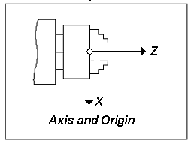jpf 1.1 Clausing Metosa Turning Center, CNC 1540
This is the official name of the CNC Lathe that will be used in the lab. If features powered hand wheels for the X and Z-axis, fully enclosed guarding, and precision ground whey’s and ball screws for highly accurate positioning. This is a very expensive piece of lab equipment so if you have any questions or doubts about what you are doing, ASK SOMEONE WHO KNOWS. The axes of this machine are set up similarly to a CNC mill, except on the lathe there are only two. The X-axis is setup to move perpendicular to the rotation of the part. The Z-axis is setup to move parallel to the axis of rotation. The diagram below shows the direction and locations of the origins for the X and Z-axis.
 Figure 1. Orientation of the axes on CNC lathe.
Figure 1. Orientation of the axes on CNC lathe.
The tool moves away from the headstock in the positive Z direction, and toward the operator in the positive X direction. This is the world coordinate system. You may also specify a local coordinate system called the home position. On this machine the home position is already set approximately 1 inch from the head stock in the Z direction and right on the Z axis in the X direction. There are also soft limits set up so that the user is not allowed to move more than 1 inch passed the home position in the negative direction. The way the home position is currently set it is impossible to hit the headstock.
The machine is also equipped with an automated tool changer, which will rotate the called tool into the cutting position. The location of the tip of this tool is what is programmed. Therefore it is very important to know what type of tool is loaded. Currently there are three tools loaded in the machine. They are listed below.
jpf 1.1.1 Turning Tool - Most commonly used for facing and profiling and tapering. Tool #8.
Grooving Tool - Most commonly used for making small groves. Tool #6.
Collet - Used to hold drilling and tapping tools. Tool #3.
Cutoff tool - Used to cut off the finished work piece